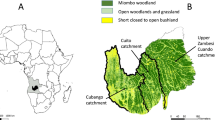Abstract
An evolving understanding of ecological processes, together with ambiguities in National Park Service policy, have led to multiple interpretations of the role of management in our large natural area National Parks. National Park Service management policies must be dynamic and responsive to changes in scientific knowledge and societal values. We propose that the principal aim of NPS resource management in natural areas is the unimpeded interaction of native ecosystem processes and structural elements. The case of the changing role of natural fire management is used as an example in developing this rationale.
Similar content being viewed by others
Literature cited
Arno, S. F. 1985. Ecological effects and management implications of Indian fires. Pages 81–86in Proceedings: symposium and workshop on wilderness fire, Missoula, Montana, 15–18 November 1983. USDA general technical report INT-182.
Bancroft, L., T. Nichols, D. Parsons, D. Graber, B. Evison, and J. van Wagtendonk. 1985. Evolution of the natural fire management program at Sequoia and Kings Canyon National Parks. Pages 174–180in Proceedings: symposium and workshop on wilderness fire, Missoula, Montana, 15–18 November 1983. USDA general technical report INT-182.
Bonnicksen, T. M. 1983. The National Park Service and local communities: a problem analysis.Western Wildlands 9:11–13.
Bonnicksen, T. M., and E. C. Stone. 1982a. Managing vegetation within U.S. National Parks: a policy analysis.Environmental Management 6:101–102 and 109–122.
Bonnicksen, T. M., and E. C. Stone. 1982b. Reconstruction of a presettlement giant sequoia-mixed conifer forest community using the aggregation approach.Ecology 63:1134–1148.
Graber, D. M. 1983. Rationalizing management of natural areas in national parks.George Wright Forum 3:48–56.
Heinselman, M. L. 1978. Fire in wilderness ecosystems. Pages 249–278in J. C. Hendee, G. H. Stankey, and R. C. Lucas (eds.), Wilderness management. USDA Forest Service miscellaneous publication 1365. 381 pp.
Leopold, A. S., S. A. Cain, C. M. Cottam, J. M. Gabrielson, and T. L. Kimball. 1963. Wildlife management in the national parks.American Forestry 69:32–35 and 61–63.
Lewis, H. T. 1973. Patterns of Indian burning in California: ecology and ethnohistory. Ballena Press, Ramona, CA.
McCool, S. F. 1983. The national parks in post-industrial America.Western Wildlands 9:14–19.
Author information
Authors and Affiliations
Rights and permissions
About this article
Cite this article
Parsons, D.J., Graber, D.M., Agee, J.K. et al. Natural fire management in National Parks. Environmental Management 10, 21–24 (1986). https://doi.org/10.1007/BF01866414
Issue Date:
DOI: https://doi.org/10.1007/BF01866414




